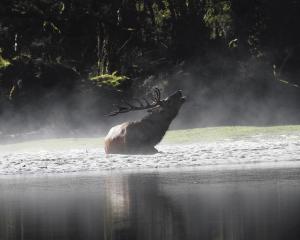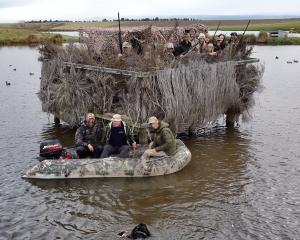
Shrek the Sheep ('the sheep' necessary thanks to the Dreamworks legal team, more on that later) found overnight fame in April 2004, after musterer Ann Scanlan found perhaps the only farm animal that will ever be described as a "rock star" on John Perriam's Otago high-country farm.
"What you do when you get up to start mustering is you have a big bark-up just on daylight," Perriam told RNZ's Nights.
"And so the dogs light up and you can hear that echoing around the hills as far as Cromwell, the sheep start moving, you follow them through to the end of the block through the bluffs and everything.
"And we got to the faraway gate to put them down to a lower block, and Ann came running down the hill and saying she'd just seen this amazing woolly - and I knew she meant what she was saying because she had done a lot of mustering in the day.
"So we went back up and there was this, looked like a godlike creature standing on top of the bluffs, 500 feet drop around them, totally wool blind. And in that situation if a sheep gets spooked, he would just go straight over a bluff," he said.
"Ann said, 'Let me have a go at catching him.'"
Perriam let her, and they soon had him on the back of their Toyota.
"We had a stud shed down there. We put him in the stud shed, he was bumping around the walls totally blind. Then the bizarre started happening."
A group of teenagers they were billeting for the New Zealand Pony Club champs "rolled up in their trucks" and asked Perriam where they could put their saddles.
"I said, 'Put them in the shed there, but be careful - there's a woolly bumping around in there.' And so they do that. Went in a minute later, here they are all are standing on the rails, fascinated by this overgrown woolly sheep.
"I said to one of the girls, 'You think we should name this thing something?' And one girl said, 'It looks like an ogre.' And of course, I wasn't really aware of the films, thank god… [Another] girl said… 'What about calling him Shrek?' That was all right."
There was talk Shrek might be of interest to the local news. Perriam knew Stephen Jaquiery from the Otago Daily Times.
"So Stephen came... and he was very unimpressed, but here's this big woolly we want to take a photo of. He said, 'Well, take it up to the rocks here and see what we can do.' … and then just miracles started to happen."
Someone bet musterer Daniel Devine - also known as 'Cage Fighter' - he could not carry Shrek and his 27kg of wool on his shoulders. He proved them wrong, and the photo Jaquiery shot soon graced the newspaper's front page.
And within 24 hours "he was in every newspaper in every country", then the world.
"We got completely snowed under by the media. But I had been heavily involved with setting up a grower marketing company called Merino New Zealand, so I was quite used to handling the media, but not to that extent. And so it was a dream come true. It was a marketer's dream. And Saatchi said at that time it was worth over $100 million to the New Zealand economy, which I found hard to believe.
"Then it started to roll on, and the next thing, Heather - my late wife - we started to feel cornered. Everybody was saying it was a jack-up."
Feeling public opinion turning sour, Perriam got in touch with his friends at charity Cure Kids, which got celebrities like Jonah Lomu involved in using Shrek to raise money for good.

"He said, 'No, no, no, no, I'm going to do it.' He organised the shearing in Cromwell. A week later it was filmed on CNN and went to over a billion people around the world, and so it just became a phenomenon, really."
Once shorn, Perriam thought Shrek's 15 minutes were over.
"Who would want to see an old skinny sheep?"
Turns out, at least a million people did. Perriam talked to clothing label Icebreaker, who made Shrek a jacket [https://collections.tepapa.govt.nz/object/1414170].
"Icebreaker got over a million hits in 24 hours, which was fantastic because they gave me $40,000 to go to Cure Kids… that was great."
Most of Shrek's wool was unusable he said, which worked out okay.
"We turned that to our advantage with Cure Kids because so many people were wanting a part of it. We made little red boxes with a glass window on the top with a staple in there. And the story on the top…. Yeah, we made thousands of dollars. Some of those staples of wool sold for $1500, $2000, and each one was numbered."
At one point, Shrek met then-prime minister Helen Clark.
"Quite often Helen Clark would say to me in future years, that that darn sheep would [be with] me everywhere I go… He knew he was good. He was a rock star, and so that's the way you had to treat him."
A couple of years later, Perriam was being criticised by other farmers that Shrek needed shearing again, and that he was sending the wrong message by letting him grow out again. Perriam agreed.
"People expected to see him with a lot of wool on. And so that drove us to doing something that second year in a way of getting him shorn…
"This item came on the radio that these icebergs were floating up from Antarctica, and I thought, oh, this could be interesting. So I ring Steve Jaquiery and see what he thinks of this idea. There was a long silence, and he said, 'You're f-ing well mad.' You know, they just rescued the Channel Nine team off one south of Stewart Island.
"But then he rang back a quarter of an hour later and said, Graeme Gale from Otago Helicopters thinks this is a fantastic idea."
They left under cover of darkness to avoid security, and an hour later were hovering above "these big grey ghosts".
"The helicopters wouldn't land. They went down on full power, dropped Shrek off, myself, Steven Jaquiery and a photographer. And by that stage Jimmy Barnett had come on board - a blade shearer from Canterbury. You could hear this like, lightning a way down, and thunder. The whole thing started shuddering and I was thinking then it might be all over.
"Fortunately, it settled down. Jimmy said, 'We may as well get on the job.'"
The risky stunt saw more money rolling in for Cure Kids.
"People expected to see him with a lot of wool on, and so that drove us to doing something that second year in a way of getting him shorn… it'll be the first and last time the sheep will ever be shown in front of that many people around the world, but it went well… When you get into that sort of publicity, you've got to take risks."
At one point Dreamworks, the movie studio behind the Shrek films, came for their cut. Perriam's lack of interest in animated cinema in the early 2000s had come back to haunt him.
Perriam told Nights he was lucky to have had Cure Kids on board, and their lawyers from Russell McVeigh.
"The Dreamworks solicitors and Russell McVeigh squared off, and they came to an understanding or an agreement that it wasn't a deliberate thing that we were doing, it just came out of nowhere - and that the whole population of New Zealand was on board with it, and the world.
"So they agreed that as long as we called him 'Shrek the Sheep' and didn't go with commercial products, they were happy to put it to bed."
Shrek died in 2011, aged 16-ish. His memory lives on in two - yes, two - statues in Tarras.
The 20th anniversary of Shrek's discovery will be on April 14.















